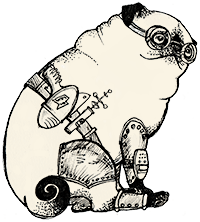

Written August 8, 2013. Tagged Ruby.
Too many people inherit from Struct.new(:some, :attributes) as a shorthand without understanding the implications.
Take this for example:
class Greeter < Struct.new(:person)
def greet
puts "Hello, #{person.name}!"
end
endSure, it's convenient. It saves you writing an initializer. But that's not all it does.
That class will happily let you instantiate a Greeter.new without an argument, and later explode as person is unexpectedly nil:
greeter = Greeter.new
greeter.greet # => raises NoMethodError: undefined method `name' for nil:NilClassA struct that takes five arguments will happily instantiate with four, or one, or none.
This may be exactly what you want, but if not, don't inherit from Struct.
Your Greeter instances will have public person and person= methods.
joe = Person.new
bob = Person.new
greeter = Greeter.new(joe)
greeter.person = bob
greeter.person # => bobIf you don't need them, the public interface of your class will be larger than necessary. Encapsulation of person is poor.
This may be exactly what you want, but if not, don't inherit from Struct.
To me, Struct is a data container; a glorified hash.
They're excellent when data containment is all you need:
Item = Struct.new(:title, :price, :url)
# …parsing some input…
items << Item.new(link.title, price.content, link.href)
# …
items.each { |item| puts item.title }But when you're modelling a domain concept and expect to have domain behavior, inheriting from a data container is weird.
Struct has a bunch of data container methods that your class will inherit: length, members, each_pair, values, values_at and more.
Do you think of your class as a specialized data container? If not, don't inherit from Struct.
Thanks to Tom Ward and Myron Marston for pointing this out in the comments.
Two Structs are considered equal if they have the same attribute values:
Person = Struct.new(:name)
john1 = Person.new("John Smith")
john2 = Person.new("John Smith")
jake = Person.new("Jake Lloyd")
[john1, john2, jake].uniq.length # => 2
{ john1 => 7, john2 => 8, jake => 9 }.length # => 2
john1 == john2 # => true
john1 == jake # => falseThis might be what you want, but if it's not, don't inherit from Struct, as it might bite you in the behind.
Even if you insist on using Struct, subclassing may not be the way. The docs don't recommend it, as it creates an unused anonymous class.
Instead, you're meant to assign a constant:
Greeter = Struct.new(:person) do
def greet
puts "Hello, #{person.name}!"
end
endThis doesn't mitigate any of the problems I listed, though, so everything above still applies.
I've also seen claims that subclassing Struct can cause superclass mismatch errors with Rails class reloading, but I've been unable to replicate that.
The obvious alternative is to just type it out:
class Greeter
def initialize(person)
@person = person
end
def greet
puts "Hello, #{@person.name}!"
end
endBut the boilerplate can get annoying to type all the time, and it can distract the reader from the interesting bits.
If you want to encapsulate @person in a private reader, that's even more boilerplate.
I wrote the attr_extras gem for this purpose. Where I work, we use it in every project.
With attr_extras you could do:
class Greeter
attr_initialize :person
attr_private :person
def greet
puts "Hello, #{person.name}!"
end
endOr shorter but more obscure:
class Greeter
pattr_initialize :person
def greet
puts "Hello, #{person.name}!"
end
endYou don't inherit anything, all arguments are required, and there are no public accessors unless you explicitly declare them.
Another option is the Values lib, which is similar to Struct but requires all arguments and provides public readers but not writers. It has similar object identity as Struct.
These are just some options. Whether or not you like them, the implications of using Struct remain, so take that into account.